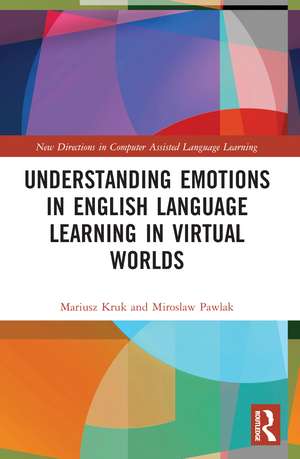Understanding Emotions in English Language Learning in Virtual Worlds: New Directions in Computer Assisted Language Learning
Autor Mariusz Kruk, Miroslaw Pawlaken Limba Engleză Paperback – 25 sep 2023
The authors divide emotions into positive (i.e., enjoyment and curiosity) and negative (i.e., boredom and language anxiety) and explore their role in L2 teaching and learning in CALL environments from theoretical, empirical and pedagogical perspectives. The book begins with a theoretical overview of selected issues concerning positive and negative emotions and surveys the studies that have dealt with this issue in L2 learning in conventional settings and CALL. The empirical part of the book is devoted to a research project which explores the experience of positive and negative emotions in learning English in the virtual world Second Life, the relationships of the emotions in question and factors influencing them. The book concludes by recommending a selection of practices which can help maximize the positive emotions and minimize the negative emotions in foreign language learning in CALL environments.
This is an important and illuminating read for students and scholars of applied linguistics, second language education and educational technology who are interested in CALL and in incorporating VW/VR-based language learning programs into their studies and teaching.
| Toate formatele și edițiile | Preț | Express |
|---|---|---|
| Paperback (1) | 379.30 lei 6-8 săpt. | |
| Taylor & Francis – 25 sep 2023 | 379.30 lei 6-8 săpt. | |
| Hardback (1) | 997.58 lei 6-8 săpt. | |
| Taylor & Francis – 14 apr 2022 | 997.58 lei 6-8 săpt. |
Preț: 379.30 lei
Nou
Puncte Express: 569
Preț estimativ în valută:
72.58€ • 75.78$ • 60.07£
72.58€ • 75.78$ • 60.07£
Carte tipărită la comandă
Livrare economică 04-18 aprilie
Preluare comenzi: 021 569.72.76
Specificații
ISBN-13: 9781032145938
ISBN-10: 1032145935
Pagini: 140
Ilustrații: 10 Tables, black and white; 8 Line drawings, black and white; 8 Illustrations, black and white
Dimensiuni: 156 x 234 x 8 mm
Greutate: 0.21 kg
Ediția:1
Editura: Taylor & Francis
Colecția Routledge
Seria New Directions in Computer Assisted Language Learning
Locul publicării:Oxford, United Kingdom
ISBN-10: 1032145935
Pagini: 140
Ilustrații: 10 Tables, black and white; 8 Line drawings, black and white; 8 Illustrations, black and white
Dimensiuni: 156 x 234 x 8 mm
Greutate: 0.21 kg
Ediția:1
Editura: Taylor & Francis
Colecția Routledge
Seria New Directions in Computer Assisted Language Learning
Locul publicării:Oxford, United Kingdom
Public țintă
Postgraduate, Professional, and Undergraduate AdvancedCuprins
Introduction 1. Positive and negative emotions: Overview of selected theoretical issues 2. Research on positive and negative emotions in L2 learning and teaching in conventional settings and CALL 3. Methodology of the research project 4. Research findings 5. Conclusion
Notă biografică
Mariusz Kruk, PhD, works at the University of Zielona Góra, Poland. His main areas of interest include individual difference variables (e.g., boredom, motivation, anxiety) and the application of technology in foreign language learning and teaching.
Mirosław Pawlak is Professor of English at Adam Mickiewicz University, Kalisz, Poland, and State University of Applied Sciences, Konin, Poland. His research interests include form-focused instruction, corrective feedback, learner autonomy, learning strategies, motivation, willingness to communicate, emotions in L2 learning and teaching, study abroad and pronunciation teaching.
Mirosław Pawlak is Professor of English at Adam Mickiewicz University, Kalisz, Poland, and State University of Applied Sciences, Konin, Poland. His research interests include form-focused instruction, corrective feedback, learner autonomy, learning strategies, motivation, willingness to communicate, emotions in L2 learning and teaching, study abroad and pronunciation teaching.
Descriere
This book contributes to overcoming the deficit in research on emotions in foreign language learning in the domain of computer assisted language learning in both traditional and virtual settings. This is an important and illuminating read for students and scholars of applied linguistics, second language education and educational technology.



